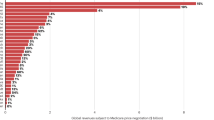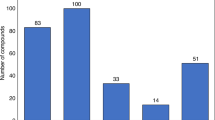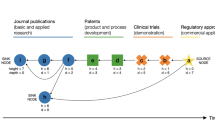Abstract
Critics decry the lack of 'truly innovative' new medicines and question the role of the pharmaceutical industry in creating the few that are developed. Is this an accurate portrayal of the state of pharmaceutical innovation? Does major pharma still innovate? If so, how? Must the industry innovate to survive? These and related issues are discussed.
This is a preview of subscription content, access via your institution
Access options
Subscribe to this journal
Receive 12 print issues and online access
$209.00 per year
only $17.42 per issue
Buy this article
- Purchase on Springer Link
- Instant access to full article PDF
Prices may be subject to local taxes which are calculated during checkout







Similar content being viewed by others
References
Scherer, F. M. The link between gross profitability and pharmaceutical R&D spending. An analysis that answers the question: what does the pharmaceutical industry really do with its profits? Health Affairs 20, 216–220 (2001).
US Congress, Office of Technology Assessment. Innovation and Commercialization of Emerging Technology OTA-BP-ITC–165 (Washington DC, US Government Printing Office, 1995).
National Research Council. Prospectus for national knowledge assessment. Committee on Knowledge Assessment Office of International Affairs (Washington DC, National Academy Press, 1996).
Booth, B. L. & Zemmel, R. W. The search for blockbuster drugs: efficacy isn't everything. The McKinsey Quart. 4 (2004).s
Wertheimer, A., Levy, R. & O'Connor, T. Too many drugs? The clinical and economic value of incremental innovations'. Investing in health: the social and economic benefits of health care innovation 14, 77–118 (2001).
Roberts, P. W. Product innovation, product-market competition and persistent profitability in the U. S. pharmaceutical industry. Strategic Manag. J. 20, 655–670 (1999).
Grabowski, H. & Vernon, J. in Competitive Strategies in the Pharmaceutical Industry. (ed. Helms, R.) 194–207 (Washington DC, AEI, 1996).
Ben-Asher, D. In need of treatment? Merger control, pharmaceutical innovation & consumer welfare. Discussion Paper No. 270 (Harvard Law School, Boston, 1999).
Congress of the United States Congressional Budget Office. How Increased Competition from Generic Drugs has Affected Prices and Returns in the Pharmaceutical Industry (Washington DC, US Government Printing Office, 1998).
Federal Trade Commission. To Promote Innovation: the Proper Balance of Competition and Patent Law and Policy [online], <http://www.ftc.gov/os/2003/10/innovationrpt.pdf> (2003).
Grabowski, H. G. Patents and new product development in the pharmaceutical and biotechnology industries. Georgetown Public Policy Rev. 8, 87–104 (2003).
US Congress, Office of Technology Assessment. Pharma-ceutical R&D: Costs, Risks and Rewards OTA-H–522 (Washington DC, US Government Printing Office, 1993).
Pharmaceutical Research and Manufacturers of America. Industry Profile 2003 [online], <http://www.phrma.org/publications/> (2003).
Grabowski, H., Vernon, J. & DiMasi, J. Returns on R&D for 1990s new drug introductions. Pharmacoeconomics 20, 11–29 (2002).
US Congress, Office of Technology Assessment. Patent Term Extension and the Pharmaceutical Industry (Washington DC, US Government Printing Office, 1981).
Pharmaceutical Research and Manufacturers of America. Delivering on the Promise of Pharmaceutical Innovation: the Need to Maintain Strong and Predictable Intellectual Property Rights [online], <http://www.ftc.gov/os/comments/intelpropertycomments/phrma020422.pdf> (2002).
Van Horn, C. E. in Biotechnology Innovation Report 2004 Benchmarks (ed. Michelson A. M.) 1–33 (Washington DC, Finnegan, Henderson, Frabow, Garrett & Dunner, LLP, 2004).
McGahan, A. & Silverman, B. How does innovative activity change as industries mature? Intl J. Ind. Organ. 19, 1141–1160 (2001).
National Science Foundation. Science and Engineering Indicators 2004 Vol. 2. [online], <http://www.nsf.gov/sbe/srs/seind04/start.htm> (2004).
National Science Foundation. Survey of Industrial Research and Development 1953–2003 [online], <http://www.nsf.gov/sbe/srs/sird/start.htm> (2004).
US Department of Labour: Bureau of Labour Statistics Occupational Employment Statistics [online], <http://www.bls.gov/oes/home.htm#overview>
Reichert, J. M. & Paquette C. Therapeutic recombinant proteins: trends in US approvals 1982 to 2002. Curr. Opin. Mol. Ther. 5, 139–147 (2003).
Parexel's R&D Statistical Sourcebook 2004/2005 (ed. Mathieu, M. P.) (Parexel Intl Corp., Waltham, 2004).
Anonymous. From pipeline to market 2004. R&D Directions 10, 19–74 (2004).
Patent Statistics Reports [online], <http://www.uspto.gov/web/offices/ac/ido/oeip/taf/reports.htm>
Pharmaceutical Research and Manufacturers of America. Industry Profile 2004 [online], <http://www.phrma.org/publications/> (2004).
Department of Health and Human Services National Institutes Of Health. NIH response to the conference report request for a plan to ensure taxpayers' interests are protected [online], <http://www.nih.gov/news/070101wyden.htm> (2001).
Department of Health and Human Services National Institutes of Health report to Congress on affordability of inventions and products [online], <http://ott.od.nih.gov/NewPages/211865ottrept.pdf> (2004).
Center for Drug Evaluation and Research. Report to the Nation 2003: Improving Public Health Through Human Drugs [online], <http://www.fda.gov/cder/reports/rtn/2003/Rtn2003.pdf> (2003).
Acknowledgements
I would like to thank D. Cohen for his assistance with data collection and C. Neslusan and the anonymous reviewers for critical reading of the manuscript.
Author information
Authors and Affiliations
Ethics declarations
Competing interests
The author declares no competing financial interests.
Related links
Rights and permissions
About this article
Cite this article
Cohen, F. Macro trends in pharmaceutical innovation. Nat Rev Drug Discov 4, 78–84 (2005). https://doi.org/10.1038/nrd1610
Issue Date:
DOI: https://doi.org/10.1038/nrd1610
This article is cited by
-
Life sciences intellectual property licensing at the Massachusetts Institute of Technology
Nature Biotechnology (2021)
-
Innovation in pharmaceutical R&D: mapping the research landscape
Scientometrics (2020)
-
Drug discovery in ophthalmology: past success, present challenges, and future opportunities
BMC Ophthalmology (2016)
-
Clinical development success rates for investigational drugs
Nature Biotechnology (2014)
-
Defining “Innovativeness” in Drug Development: A Systematic Review
Clinical Pharmacology & Therapeutics (2013)



